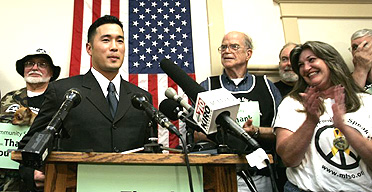Now Playing: Bob Woodruff
Topic: Media Involvement
Bob Woodruff's 'To Iraq and Back' on ABC
Do you remember Bob Woodruff, an ABC journalist, who while covering the war in Iraq last year (he was literally in Iraq in Jan 2006) was severely injured by IED explosion, along with the other soldiers in the humvee? If you didn't see the 'must see'airing of Bob Woodruff 'To Iraq and Back' last night, you can still see it online at ABC website.
Traumatic Brain Injury - TBI - heard of it? Of the over 200,000 (that's right 200 thousand - much more than the figure cited by DOD) injured troops in Iraq, a quarter of those suffer with traumatic brain injury.
That is a quite high percentage but what is more astonishing is that the smaller VA hospital/centers don't have the knowledge, equipment, people power, staff or professionals to deal with it. I don't suppose it would surprise anyone to realize that TBI is another one of those 'issues' being sanitized and swept out of public view.
(Senators Murray and Cantwell - all our Congress Representatives - are you aware and are our VA hospitals in Washington equipped to treat follow up care for TBI soldiers? Wouldn't you want not one more soldier to have to face this kind of a homecoming? )
Thanks to the courage of ABC journalist/reporter, Bob Woodruff, and ABC's willingness to air it, special tv production 'To Iraq and Back' finds a middle ground arena (not slung with partisan politics) to try to educate the public on the plight of many of these injured, returning soldiers. If you didn't get chance to see it last night on tv, you can watch the online video here at ABC website.
Bob Woodruff was injured while reporting in Iraq, and he has made a recovery from his own traumatic brain injury (TBI) many in the medical profession view as remarkable. Which isn't to say he has completely recovered, rather that he has learned to compensate and inspires hope for other soldiers trying to adjust to life with TBI. He has made this tv special, 'To Iraq and Back' which aired on ABC, Tuesday night, Feb 27, 2007.
It chronicles his life starting from the IED explosion he experienced in the humvee in Iraq, the evac and medical journey, and his efforts at recovery. You will see some graphic reality. You will see Bob (and other soldiers) with half his head blown off, in recovery, with what is becoming the traditional 'helmet' TBI survivors wear and you will see glimpses of his efforts to retrain his memory.
As Bob goes back to the medical and hospital staff to thank them, he interviews them along the way and the viewer gets some firsthand information from those who have an up close and personal view of the enormity of injuries sustained by our troops. He then visits some of the soldiers on the humvee with him when the IED exploded.
He visits with other soldiers who have TBI and talks with the soldiers and their families about the resources or lack of resources after being released from the primary hospitals - Walter Reed and Bethesda. As those soldiers return to their homes in communities across the nation, the VA resources are not up to speed in treating them for TBI. (Most of you who know much about VA resources, already know the shortages of hospitals, centers, staff and services) .
Bob talks also with new VA Secretary, Jim Nicholson, or perhaps interviews him, because it looks very much to me like Jim Nicholson, is very uncomfortable with the questions Bob Woodruff puts to him. And they are not challenging or difficult questions, more straightforward kinds of questions, deserving of factual and straightforward answers. Something Jim Nicholson does not provide. His responses seem to me like efforts to minimize the severity and seriousness and strike me as the kind of defensive answers one gives when one knows what one is being asked reveals a truth being cloaked.
Mentioned in the tv show is Wounded Warriors Project - please see their website and help in whatever ways you can.
Excerpt from Wounded Warriors Project on Bob Woodruff's 'To Iraq and Back'
On Tuesday, February 27th at 10pm (EST), ABC will air the much anticipated special featuring ABC News Anchor Bob Woodruff's injury and rehabilitation after suffering a Traumatic Brain Injury (TBI) while covering the war in Iraq.This September, the Wounded Warrior Project had the distinct pleasure of meeting Bob in Washington DC at a TBI Caregiver Summit. The goal of the summit was to bring together family caregivers of service members who have incurred serious traumatic brain injuries during the war against terror and facilitate a dialogue between these family caregivers and key policy and legislative decision makers in Washington.
Part of this summit and a roundtable discussion between Bob and the family caregivers (and some patients themselves) will be included in the piece.
Another excerpt:
At a hearing held last June by the House of Representatives Committee on Veterans Affairs, Department of Veterans Affairs Under Secretary for Health Jonathan Perlin testified that, "Traumatic Brain Injury accounts for almost 25 percent of combat casualties suffered in OIF/OEF by US Forces." With over 20,000 combat injuries to date during the ongoing global war on terror, this means that there are almost 5,000 service members suffering from traumatic brain injuries. While advances in body armor and battlefield medicine save the lives of many soldiers, they do not protect against impacts that cause brain injury.
An excerpt from Discover Magazine, article Dead Men Walking; What sort of future do brain-injured Iraq veterans face.
While the Pentagon has yet to release hard numbers on brain-injured troops, citing security issues, brain-injury professionals express concern about the range of numbers reported from other military-related sources like the Defense and Veterans Brain Injury Center, the Department of Defense, and the Department of Veterans Affairs (VA). One expert from the VA estimates the number of undiagnosed TBIs at over 7,500. Nearly 2,000 brain-injured soldiers have already received some level of care, but the TBIs--human beings reduced to an abbreviation--keep coming.








 (photo - on the Panel - Elizabeth Falzone - GSFSO/ MFSO - WA chapter and Rich Moniak - MFSO - Alaska chapter listen to two days of testimony)
(photo - on the Panel - Elizabeth Falzone - GSFSO/ MFSO - WA chapter and Rich Moniak - MFSO - Alaska chapter listen to two days of testimony)


 (photo - Stacy Bannerma, wife of returning Iraq veteran - WA Natl Guard, gives testimony)
(photo - Stacy Bannerma, wife of returning Iraq veteran - WA Natl Guard, gives testimony)

 (photo Lietta Ruger, MFSO- WA, in support Lt. Ehren Watada, June 2006, Tacoma, WA)
(photo Lietta Ruger, MFSO- WA, in support Lt. Ehren Watada, June 2006, Tacoma, WA)
 (photo - Lietta Ruger, Judy Linehan, Jenny Keesey - from MFSO - WA chapter, June 2006, Tacoma, WA)
(photo - Lietta Ruger, Judy Linehan, Jenny Keesey - from MFSO - WA chapter, June 2006, Tacoma, WA) (photo - Judy Linehan, MFSO - WA at support rally for Lt. Watada, June 2006, Tacoma, WA)
(photo - Judy Linehan, MFSO - WA at support rally for Lt. Watada, June 2006, Tacoma, WA)






 photo - Sue Niederer, MFSO. Her son U.S. Army 2nd Lt.Seth Dvorin, 24 yrs old was killed in Iraq Feb 3, 2004.
photo - Sue Niederer, MFSO. Her son U.S. Army 2nd Lt.Seth Dvorin, 24 yrs old was killed in Iraq Feb 3, 2004. photo - Nancy Lessin, MFSO Co-Founder
photo - Nancy Lessin, MFSO Co-Founder  photo - Lietta Ruger, MFSO - WA
photo - Lietta Ruger, MFSO - WA  photo - Stacy Bannerman, MFSO - WA
photo - Stacy Bannerman, MFSO - WA



